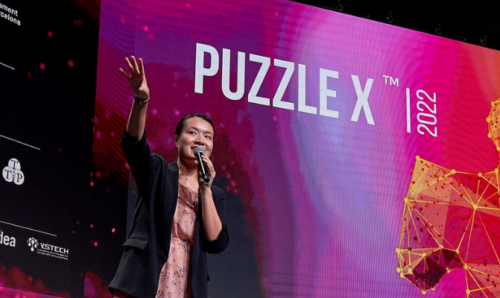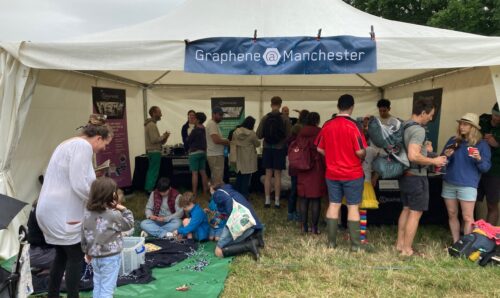Women in a 2D world
National Graphene Institute Research 8 March 2019
Following up the #WomenInGraphene conference hosted at the National Graphene Institute funded by the Graphene Flagship last month, I took the opportunity to interview two female graphene researchers, Professor Sarah Haigh and PhD candidate Clara Skuse, to talk about their perceptions of gender equality in their field of research. With graphene research verging on the fields of materials’ science, chemistry and biology rather than pure physics or engineering and thus encompassing a much larger proportion of female scientists, I wanted to find out whether they had experienced any of the gender stereotypes and discrimination that sometimes unfortunately still accompany the world of science.
While conducting these interviews, I encountered two strong, inspirational and self-confident women prepared to work hard for where they wanted to be, ready to identify obstacles in their paths and tackle them head-on. Rather than being discouraged by words or acts of opposition and rejection in their careers, Sarah suggests challenging discrimination by constructive evaluation, thus disarming generalised and prejudiced claims. Drawing from personal experience, she advises asking ‘what exactly is demanded in order to get the job done’ rather than accepting the outdated, vague ‘it is not a job for women’. This approach gives female scientists a clear understanding of the task at hand, allows them to assess their own capabilities, while crumbling colleagues’ gender prejudice in the process.
The Women In Graphene conference echoed this advice by providing constructive feedback on how to improve your CV and giving practical paper-writing help. While the so-called ‘leaky pipe phenomenon’, i.e., the decreasing number of female scientists along advancing career stages, was broached during some of the talks, a clear focus was placed on successful, proactive career development, structured networking, empowering participants and enhancing vital researcher skills.
Apart from practical advice, a talk by Jess Wade addressed the issue of inspiring female role models in the sciences. In an attempt to counter the deficit in Wikipedia articles on female researchers (only 17.7% of Wikipedia biographies written in English are about women) which reflects the disproportionately male dominated editorship, she set herself to publish female scientists’ and engineers’ biographies daily for more than a year.
This refreshing and inspiring approach to increase the visibility of female role models became Clara’s favourite contribution presented at the conference. In her eyes, not only did this effort give credit and recognition to amazing scientists, but it embedded their achievements in a societal framework not exclusively branded as “women-science”. Sarah comments, “the vital importance of contributions like Jess’s to Wikipedia were clearly demonstrated to me when she told us how she sometimes has to fight to keep her entries published because the website’s acceptance criteria for biographies still disproportionately favour male researchers”.
Acknowledging female researchers on the basis of their merit rather than their gender is a perspective that also resonates with Sarah. On the one hand, outreach activities may benefit from disproportionate representation of female scientists, as they can raise awareness of women’s contribution to science and reform gender stereotypes within the next generation. However, she feels it is important that the need for diversity, for example on interview panels, at progression meetings, and in outreach does not overly burden, and therefore negatively impact, minority staff and students.
In Sarah’s view, careful monitoring of unconscious bias in job adverts and administrative policies can help, and in particular setting transparent and realistic criteria for job and project selection will benefit everyone.
While these efforts are crucial to remedy the existing societal gender bias in academia, both researchers agree that the issue of gender equality has to be incorporated into children’s education at a much younger age. Improving the visibility of inspirational role models, be they male or female, as well as promoting inclusivity will become one of the core challenges of our time. Public attitudes and norms are changing, deems Sarah, as women confront prejudice and refuse to accept discrimination. But solidified stereotypes may be hard to break.
According to Clara, boys as well as girls should be nudged out of their comfort zone to embrace the challenges and opportunities of gender diversity: encourage girls to explore fields in technology and boys to embrace subjects that may not be seen as ‘manly’ before making up their mind about their future career. She says, “we need to encourage both girls and boys to challenge the ideals and social pressure behind the words ‘masculinity’ and ‘femininity’ to really achieve gender equality”.
In building those careers, Clara cautions not to overlook other women in the field. While women are sometimes perceived to be harder on female competitors than their male peers, in her experience collaboration in purely female and mixed settings can be equally valuable, diversifies perspectives and fully utilises society’s potential.
A last word of advice from Prof Haigh for aspiring young researchers concerns courage and daringness. While men will more readily apply for jobs they are not entirely qualified for, women often hesitate thus missing out on amazing opportunities. Rejection is part of the experience, but never having tried will certainly not lead to success. “Go for it!”, she says.
So, stop reading this blog for now, find yourself a challenge and buckle up for all the fun, curious adventures and joy of discovery that graphene research has to offer!




